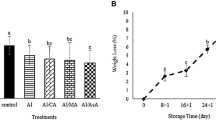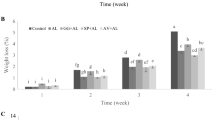Abstract
Sweet cherry fruits harvested at commercial maturity stage were treated with an edible coating based on sodium alginate at several concentrations (1%, 3% or 5% w/v). The coatings were effective on delaying the evolution of the parameters related to postharvest ripening, such as colour, softening and loss of acidity, and reducing respiration rate. In addition, the edible coatings showed a positive effect on maintaining higher concentration of total phenolics and total antioxidant activity, which decreased in control fruits associated with the over-ripening and senescence processes. Results from quality parameters and antioxidant activity suggested that the maximum storability period for control fruits was 8 days at 2 °C plus 2 days at 20 °C, while alginate-coated cherries could be stored with optimal quality and enhanced antioxidant activity up to 16 days at 2 °C plus 2 days at 20 °C.






Similar content being viewed by others
References
Acevedo CA, López DA, Tapia MJ, Enrione J, Skurtys O, Pedreschi F, Brown DI, Creixell W & Osorio F (2010) Using RGB image processing for designating an alginate edible film. Food and Bioprocess Technology, doi: 10.1007/s11947-010-0453y, in press.
Alonso, J., & Alique, R. (2004). Influence of edible coating on shelf life and quality of ‘Picota’ sweet cherry. European Food Research and Technology, 218, 535–539.
Ayranci, E., & Tunc, S. (2004). The effect of edible coating on water and vitamin C loss of apricots (Armeniaca vulgaris Lam.) and green peppers (Capsicum annuum L.). Food Chemistry, 87, 339–342.
Campos CA, Gerschenson LN & Flores SK (2010) Development of edible films and coatings with antimicrobial activity. Food and Bioprocess Technology, doi: 10.1007/s11947-010-0434-1, in press.
Chaovanalikit, A., & Wrolstad, R. E. (2004). Total anthocyanin and total phenolics of fresh and processed cherries and their antioxidant properties. Journal of Food Science, 69, FCT67–FCT72.
Crisosto, C. H., Crisosto, G. M., & Metheney, P. (2003). Consumer acceptance of ‘Brooks’ and ‘Bing’ cherries is mainly dependent on fruit SSC and visual skin color. Postharvest Biology and Technology, 28, 159–167.
Díaz-Mula, H. M., Castillo, S., Martínez-Romero, D., Valero, D., Zapata, P. J., Guillén, F., et al. (2009). Organoleptic, nutritive and functional properties of sweet cherry as affected by cultivar and ripening stage. Food Science and Technology International, 15, 535–543.
Díaz-Mula, H. M., Zapata, P. J., Guillén, F., Martínez-Romero, D., Castillo, S., Serrano, M., et al. (2009). Changes in hydrophilic and lipophilic antioxidant activity and related bioactive compounds during postharvest storage of yellow and purple plum cultivars. Postharvest Biology and Technology, 51, 354–363.
Esti, M., Cinquante, L., Sinesio, F., Moneta, E., & Di Matteo, M. (2002). Physicochemical and sensory fruit characteristic of two sweet cherry cultivars after cool storage. Food Chemistry, 76, 399–405.
Fernández-Panchón, M. S., Villano, D., Troncoso, A. M., & García-Parrilla, M. C. (2008). Antioxidant activity of phenolic compounds: from in vitro results to in vivo evidence. Critical Reviews in Food Science and Nutrition, 48, 649–671.
Gonçalves, B., Silva, A. P., Moutinho-Pereia, J., Bacelar, E., Rosa, E., & Meyer, A. S. (2007). Effect of ripeness and postharvest storage on the evolution of colour and anthocyanins in cherries (Prunus avium L.). Food Chemistry, 103, 976–984.
Li, H., & Yu, T. (2001). Effect of chitosan coating on incidence or brown rot, quality and physiological attributes for postharvest peach fruit. Journal of the Science of Food and Agriculture, 81, 269–274.
Maftoonazad, N., & Ramaswamy, H. S. (2005). Postharvest shelf life extension of avocado using methyl cellulose-based coatings. Lebensmittel-Wissenschaft und Technologie, 38, 617–624.
Maftoonazad, N., Ramaswamy, H. S., & Marcotte, M. (2008). Shelf-life extension of peaches through sodium alginate and methyl cellulose edible coatings. International Journal of Food Science & Technology, 43, 951–957.
Martínez-Romero, D., Alburquerque, N., Valverde, J. M., Guillén, F., Castillo, S., Valero, D., et al. (2006). Postharvest sweet cherry quality and safety maintenance by Aloe vera treatment: A new edible coating. Postharvest Biology and Technology, 39, 93–100.
Mozetiĉ, B., Simĉiĉ, M., & Trebŝe, P. (2006). Anthocyanins and hydroxycinnamic acids of Lambert Compact cherries (Prunus avium L.) after cold storage and 1-methylcyclopropene treatment. Food Chemistry, 97, 203–309.
Navarro-Tarazaga, M. L. L., Sothornvit, R., & Pérez-Gago, M. B. (2008). Effect of plasticizer type and amount on hydroxypropyl methylcellulose-beeswax edible film properties and postharvest quality of coated plums (cv. Angeleno). Journal of Agricultural and Food Chemistry, 56, 9502–9509.
Reinoso, E., Mittal, G. S., & Lim, L. T. (2008). Influence of whey protein composite coatings on plum (Prunus domestica L.) fruit quality. Food and Bioprocess Technology, 1, 314–325.
Romanazzi, G., Nigro, F., & Ippolito, A. (2003). Short hypobaric treatments potentiate the effect of chitosan in reducing storage decay of sweet cherries. Postharvest Biology and Technology, 29, 73–80.
Ruoyi, K., Zhifang, Y., & Zhaoxin, L. (2005). Effect of coating and intermittent warming on enzymes, soluble pectin substances and ascorbic acid of Prunus persica (Cv. Zhonghuashoutao) during refrigerated storage. Food Research International, 38, 331–336.
Schreiner, M., & Huyskens-Keil, S. (2006). Phytochemicals in fruit and vegetables: Health promotion and postharvest elicitors. Critical Reviews in Plant Sciences, 25, 267–278.
Serrano, M., Guillén, F., Martínez-Romero, D., Castillo, S., & Valero, D. (2005). Chemical constituents and antioxidant activity of sweet cherry at different ripening stages. Journal of Agricultural and Food Chemistry, 53, 2741–2745.
Serrano, M., Díaz-Mula, H. M., Zapata, P. J., Castillo, S., Guillén, F., Martínez-Romero, D., et al. (2009). Maturity stage at harvest determines the fruit quality and antioxidant potential after storage of sweet cherry cultivars. Journal of Agricultural and Food Chemistry, 57, 3240–3246.
Tomás-Barberán, F. A., & Espín, J. C. (2001). Phenolic compounds and related enzymes as determinants of quality in fruits and vegetables. Journal of the Science of Food and Agriculture, 81, 853–876.
Tomás-Barberán, F. A., Gil, M. I., Cremin, P., Waterhouse, A. L., Hess-Pierce, B., & Kader, A. A. (2001). HPLC-DAD-ESIMS analysis of phenolic compounds in nectarines, peaches, and plums. Journal of Agricultural and Food Chemistry, 49, 4748–4760.
Usenik, V., Fabčič, J., & Štampar, F. (2008). Sugars, organic acids, phenolic composition and antioxidant activity of sweet cherry (Prunus avium L.). Food Chemistry, 107, 185–192.
Valero, D., & Serrano, M. (2010). Postharvest Biology and Technology for Preserving Fruit Quality. Boca Raton, USA: CRC-Taylor & Francis.
Valverde, J. M., Valero, D., Martínez-Romero, D., Guillén, F., Castillo, S., & Serrano, M. (2005). Novel edible coating based on of Aloe vera gel to maintain table grape quality and safety. Journal of Agricultural and Food Chemistry, 53, 7807–7813.
Vargas, M., Pastor, C., Chiralt, A., McClements, J., & González-Martínez, C. (2008). Recent advances in edible coatings for fresh and minimally processed fruits. Critical Reviews in Food Science and Nutrition, 48, 496–511.
Yaman, Ö., & Bayindirli, L. (2001). Effects of an edible coating, fungicide and cold storage on microbial spoilage of cherries. European Food Research and Technology, 213, 53–55.
Yaman, Ö., & Bayindirli, L. (2002). Effects of an edible coating and cold storage on shelf-life and quality of cherries. Lebensmittel-Wissenschaft und Technologie, 35, 146–150.
Zapata, P. J., Guillén, F., Martínez-Romero, D., Castillo, S., Valero, D., & Serrano, M. (2008). Use of alginate or zein as edible coatings to delay postharvest ripening process and to maintain tomato (Solanum lycopersicon Mill) quality. Journal of the Science of Food and Agriculture, 88, 1287–1293.
Acknowledgements
This work has been funded by Spanish Ministry of Science and Technology through Project AGL2006-04359/ALI and European Commission with FEDER funds. Huertas María Díaz-Mula is granted a research fellowship (BES-2007-15415) by the Spanish Ministry of Science and Technology. The authors thank “Finca Los Frutales” for permission to use their plots, for provision of the cherries and for the technical support received.
Author information
Authors and Affiliations
Corresponding author
Rights and permissions
About this article
Cite this article
Díaz-Mula, H.M., Serrano, M. & Valero, D. Alginate Coatings Preserve Fruit Quality and Bioactive Compounds during Storage of Sweet Cherry Fruit. Food Bioprocess Technol 5, 2990–2997 (2012). https://doi.org/10.1007/s11947-011-0599-2
Received:
Accepted:
Published:
Issue Date:
DOI: https://doi.org/10.1007/s11947-011-0599-2




